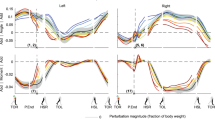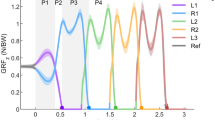Abstract
This study demonstrates a method to precisely estimate the muscular torque of a human user precisely during the use of over-ground gait rehabilitation robot which features the lower limb exoskeleton equipped with torque sensors in the hip and knee joints. The muscular torque is a very important criterion on the state of rehabilitation. The torque sensors in each joint, however, do not provide the exact muscular efforts since the dynamics of lower limb and the ground reaction forces (GRF) affect the torque. In this research, the limb dynamics are formulated, and their parameters are identified for each user to precisely compensate for the dynamic effect from the torque measurement during the swing motion. In addition, the method of estimating the user’s muscular torque in consideration of the vertical GRF during stance phase is suggested. A shoe insole with pressure sensors measures the vertical GRF, and the effect of vertical GRF on hip and knee joint torque is formulated for the inverse-dynamicsbased muscular torque estimation. The EMG has been used to analyze the muscular torque and the function of muscle in many studies and was used to validate the accuracy of the proposed method of muscular torque estimation. The experimental comparison between the estimated torque and EMG measurements show that the torque sensors and insole pressure sensors accurately estimate the muscular torque during the swing and stance phase of over-ground walking.
Similar content being viewed by others
References
A. Duschau-Wicke, J. von Zitzewitz, A. Caprez, L. Lunenburger, and R. Riener, “Path control: a method for patientcooperative robot-aided gait rehab-ilitation,” IEEE Trans. on Neural Systems and Rehabilitation Engineering, vol. 18, no. 1, pp. 38–48, February 2010. [click]
S. K. Banala, S. H. Kim, S. K. Agrawal, and J. P. Scholz, “Robot assisted gait training with active leg exoskeleton (ALEX),” IEEE Trans. on Neural Sys-tems and Rehabilitation Engineering, vol. 17, no. 1, pp. 2–8, February 2009. [click]
J. F. Veneman, R. Kruidhof, E. E. Hekman, R. Ekkelenkamp, E. H. Van Asseldonk, and H. Van Der Kooij, “Design and evaluation of the LOPES exoskeleton robot for interactive gait rehabilitation,” IEEE Trans. on Neural Systems and Rehabilitation Engineering, vol. 15, no. 3, pp. 379–386, September 2007. [click]
K. Kong, H. Moon, B. Hwang, D. Jeon, and M. Tomizuka, “Impedance compensation of SUBAR for back-drivable force-mode actuation,” IEEE Trans. on Robotics, vol. 25, no. 3, pp. 512–521, June 2009. [click]
D. J. Reinkensmeyer, D. Aoyagi, J. L. Emken, and J. A. Galvez, “Tools for understanding and optimizing robotic gait training,” Journal of rehabilitation research and development, vol. 25, no. 5, pp. 657–670, August 2006.
G. Kim, S. Kang, H. Cho, J. Ryu, M. Mun, and K. Kim, “Modeling and simulation of powered hip orthosis by pneumatic actuators,” International Journal of Control, Automation and Systems, vol. 8, no. 1, pp. 59–66, February 2010.
S. Srivastava, P. C. Kao, S. H. Kim, P. Stegall, D. Zanotto, J. S. Higginson, S. K. Agrawal, and J. P. Scholz, “Assistas-needed robot-aided gait training improves walking function in individuals following stroke,” IEEE Trans. on Neural Systems and Reha-bilitation Engineering, vol. 23, no. 6, pp. 956–963, November 2015. [click]
B. Hwang, and D. Jeon, “A method to accurately estimate the muscular torques of human wearing exoskeletons by torque sensors,” Sensors, vol. 15, no. 4, pp. 8337–8357, April 2015. [click]
C. L. Vaughan, B. L. Davis, and C. O. Jeremy, Dynamics of Human Gait, 1999.
A. Belli, P. Bui, A. Berger, A. Geyssant, and J. R. Lacour, “A treadmill ergometer for three-dimensional ground reaction forces measurement during walking,” Journal of biomechanics, vol. 34, no. 1, pp. 105–112, January 2001. [click]
G. J. Verkerke, A. L. Hof, W. Zijlstra, W. Ament, and G. Rakhorst, “Determining the centre of pressure during walking and running using an instrumented treadmill,” Journal of Biomechanics, vol. 38, no. 9, pp. 1881–1885, September 2005. [click]
P. O. Riley, G. Paolini, U. Della Croce, K.W. Paylo, and D. C. Kerrigan, “A kinematic and kinetic comparison of overground and treadmill walking in healthy subjects,” Gait & posture, vol. 26, no. 1, pp. 17–24, June 2007.
J. Bae and M. Tomizuka, “A tele-monitoring system for gait rehabilitation with an inertial measurement unit and a shoe-type ground reaction force sensor,” Mechatronics, vol 23, no. 6, pp. 646–651, September 2013.
T. Liu, Y. Inoue, K. Shibata, and K. Shiojima, “A mobile force plate and three-dimensional motion analysis system for three-dimensional gait assess-ment,” IEEE Sensors Journal, vol. 12, no. 5, pp. 1461–1467, May 2012. [click]
K. Kong, and M. Tomizuka, “A gait monitoring system based on air pressure sensors embedded in a shoe,” IEEE/ASME Trans. on Mechatronics, vol. 14, no. 3, pp. 358–370, June 2009. [click]
J. Perry and J. R. Davids, “Gait analysis: normal and pathological function,” Journal of Pediatric Ortho-paedics, vol. 12, no. 6, pp. 815, November 1992.
A. Crowe, M. M. Samson, M. J. Hoitsma, and A. A. van Ginkel, “The influence of walking speed on parameters of gait symmetry determined from ground reaction forces,” Human Movement Science, vol. 15, no. 3, pp. 347–367, June 1996. [click]
D. M. Rouffet, and C. A. Hautier, “EMG normalization to study muscle activation in cycling,” Journal of Electromyography and Kinesiology, vol. 18, no. 5, pp. 866–878, October 2008. [click]
D. A. Winter, Biomechanics and Motor Control of Human Movement, John Wiley & Sons, October 2009.
S. J. Olney, and D. A. Winter, “Predictions of knee and ankle moments of force in walking from EMG and kinematic data,” Journal of Biomechanics, vol. 18, no. 1, pp. 9–20, January 1985. [click]
P. De Leva, “Adjustments to Zatsiorsky-Seluyanov’s segment inertia parameters,” Journal of Biomechanics, vol. 29, no. 9, pp. 1223–1230, September 1996. [click]
W. T. Dempster, and G. R. Gaughran, “Properties of body segments based on size and weight,” Developmental Dynamics, vol. 120, no. 1, pp. 33–54, January 1967. [click]
A. Forner-Cordero, H. J. Koopman, and F. C. Van der Helm FC, “Inverse dynamics calculations during gait with restricted ground reaction force information from pressure insoles,” Gait&posture, vol. 23, no. 2, pp. 189–199, February 2006. [click]
Author information
Authors and Affiliations
Corresponding author
Additional information
Recommended by Associate Editor Changchun Hua under the direction of Editor Fuchun Sun. This journal was supported by the Dual-Use Technology Program of METIE/DAPA/CMTC.[13-DU-MC-16], High speed lower-limb exoskeleton robot control at rough terrain.
Beomsoo Hwang received the B.S., M.S. and Ph.D. degrees from Sogang University, Seoul, Korea, in 2007, 2009, and 2016. His current research interests include sensors for biomechatronics systems, and the design and control of humaninteractive robotics such as rehabilitation robots and exoskeleton systems.
Doyoung Jeon received the B.S. degree from Seoul National University, Seoul, Korea, in 1984 and the M.S. and Ph.D. degrees from the University of California, Berkeley, in 1986 and 1991, respectively, all in Mechanical Engineering. In 1994, he joined the Department of Mechanical Engineering, Sogang University, Seoul, where he was the Dean of Research from 2004 to 2005. His current research interests include the general areas of control systems, such as exoskeletal robots, rehabilitation robots, capsule endoscopes, and servo control of advanced manufacturing machines. He was a committee member of the Korean Presidential Advisory Council on Science and Technology from 2005 to 2006 and the Korean Presidential Commission on Policy Planning from 2002 to 2008.
Rights and permissions
About this article
Cite this article
Hwang, B., Jeon, D. Estimation of the User’s Muscular Torque for an Over-ground Gait Rehabilitation Robot Using Torque and Insole Pressure Sensors. Int. J. Control Autom. Syst. 16, 275–283 (2018). https://doi.org/10.1007/s12555-016-0545-1
Received:
Revised:
Accepted:
Published:
Issue Date:
DOI: https://doi.org/10.1007/s12555-016-0545-1




